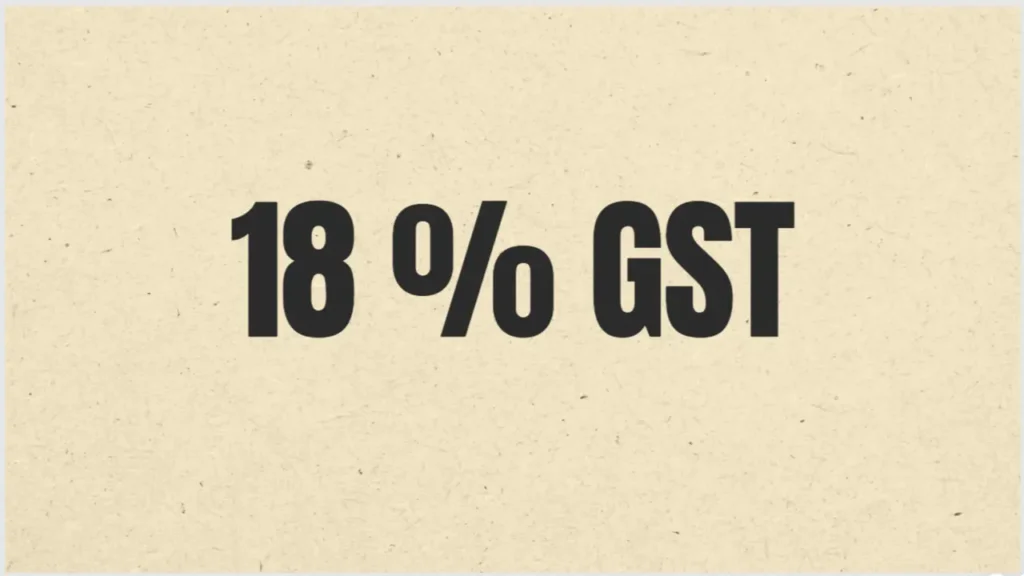Introduction
Since its introduction on 1 July 2017, India’s Goods and Services Tax (GST) has transformed indirect taxation by unifying multiple levies under a single framework. While GST is divided into multiple slabs—0%, 5%, 12%, 18%, and 28%—the 18% GST slab stands out as the country’s “standard rate.”
This category covers a vast range of goods and services that are neither essential commodities like rice or wheat nor high-end luxury or sin goods such as expensive cars and tobacco. From everyday electronics to digital services, the 18% rate is a cornerstone of GST collections and a major driver of government revenue.
What Falls Under the 18% GST Slab?
The 18% GST slab covers a broad spectrum of mid-to-high value goods and services.
Examples of goods taxed at 18%:
- Electronics: Mobile phones (post-March 2020), computer monitors, printers, cameras
- Appliances: Refrigerators, washing machines, air coolers
- Processed foods: Chocolates, biscuits, branded ice cream
- Furniture: Wooden, steel, and plastic furniture
- Industrial products: Pumps, machinery, and equipment
Examples of services taxed at 18%:
- Telecom: Mobile recharges, broadband internet plans
- Financial services: Banking charges, non-life insurance premiums
- Restaurants: AC dining and outlets serving alcohol
- IT services: Software development, cloud hosting, consulting
- Events & entertainment: Conferences, exhibitions, high-value entertainment tickets
Why the 18% Slab Exists
The GST Council set the 18% rate as the default for a large swathe of goods and services, based on:
- Revenue Backbone – One of the largest contributors to GST revenue.
- Balanced Rate – High enough to raise funds, but lower than the 28% luxury/sin rate.
- Simplification – Widely applied to avoid constant classification disputes.
- Uniformity in Services – Almost all professional and commercial services fall under this slab, streamlining compliance.
Impact on Consumers
For consumers, the 18% GST slab is often applied to purchases that are discretionary rather than essential.
- A ₹10,000 refrigerator attracts ₹1,800 in GST.
- Monthly mobile bills and broadband plans include 18% GST, making it a recurring expense.
- Electronics, home appliances, and branded snacks feel noticeably more expensive compared to pre-GST pricing.
While the rate can feel steep for middle-class households, experts note that the Input Tax Credit (ITC) system prevents double taxation, indirectly benefiting end-users by lowering embedded costs.
Impact on Businesses
Advantages:
- Full ITC benefits, reducing overall tax costs.
- A uniform rate across industries makes billing and compliance easier.
- Encourages businesses to register under GST to claim ITC.
Challenges:
- High price sensitivity in markets for non-essential goods.
- Competitive sectors may have to absorb part of the GST cost to stay attractive.
Recent Updates from the GST Council
Some notable changes over the years:
- Mobile phones: Moved from 12% to 18% in March 2020 to fix inverted duty structures.
- Hotel rooms: Rooms above ₹7,500/night shifted from 28% to 18% in 2019 to promote tourism.
- Food delivery platforms: Swiggy, Zomato, and others now collect 18% GST directly from customers.
In the 55th GST Council Meeting (December 2024), no major changes were proposed for this slab, though future rate rationalization could alter its scope.
Key Challenges in the 18% GST Category
- Price sensitivity: Even modest goods like biscuits or branded ice creams see demand fluctuations.
- Classification disputes: Businesses sometimes lobby to reclassify goods into the 12% slab.
- Inverted duty structures: Certain sectors pay more GST on raw materials than the tax on finished goods, leading to refund claims.
Future Outlook
The 18% GST slab is likely to remain central to India’s taxation system, but upcoming reforms could reshape it:
- Possible merger with the 12% slab into a single 15–16% rate.
- Expansion to absorb items currently in the 28% bracket.
- Potential relief on essential telecom and insurance services to improve affordability.
Conclusion
The 18% GST slab is the financial backbone of India’s indirect tax system—covering the widest range of goods and services and striking a balance between revenue generation and affordability. While its impact is felt in household budgets and business pricing, it ensures stability in tax collection.
